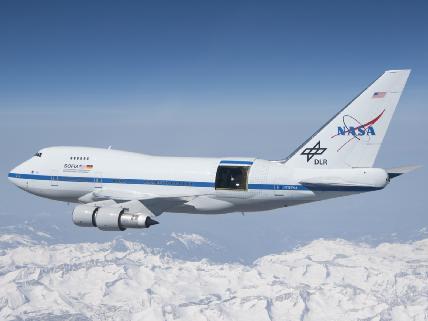Fossil-fuel solutions stratospheric cost
‘Sofia’ has cost $1.3 billion.

Finally Looking in the Wrong Place: The Stratospheric Observatory for Infrared Astronomy busy studying the atmospheres of planets not facing catastrophic risk from anthropogenic global warming. photograph Dryden Flight Research Center
If built, the Pūhoi–Wellsford Motorway is estimated to cost $2.3 billion.
Nine years behind schedule, the Stratospheric Observatory for Infrared Astronomy has just begun studying the atmospheres of other planets, when the extreme urgency is to better understand the atmosphere of Earth.
The two projects have two things in common: Stratospheric cost- and fossil-fuel-aged thinking.
The stratospheric observatory, which is based on a 1977 Boeing 747, will burn a hundred tonnes of fuel each flight. It will undoubtedly do some wonderful science, but per hour of viewing it is close to the cost of the Hubble telescope.
Likewise, the proposed Pūhoi–Wellsford would burn ruinous amounts of fuel. While it has been frequently derided as a ‘holiday road’, its function as a commuter road is of graver concern. It will potentially put Wellsford in comfortable commuting distance from Auckland—potentially, because the cost and price of fossil fuel is set to soar. Cost because the readily-available stuff is already gone, and difficult deposits are expensive and dangerous to extract. Price because fossil fuel tax has to be sharply hiked to curb fossil fuel use as global warming feedbacks force the scales from the eyes of a short-sighted populace and its politicians.
Flying the stratospheric observatory will be a boon for science and a blast for the select few scientists who get to enjoy working in the airborne laboratory. But the US$1 billion it cost to commission and the US$100 million a year it will cost to operate should have gone to projects such as that which President Barack Obama has recently revived, the Deep Space Climate Observatory.
TheTriana is finally to get her place in the neutral gravity point between the Earth and the Sun, and represents an unparalleled opportunity to study the home planet’s atmosphere. It was first mooted in 1960 but in 1998 received a boost by Al Gore, before being buried by George W Bush. The total cost of the observatory will be a mere US$66 million, about one twenty-seventh of the cost of the planned motorway. One will help save life on this planet; the other would help doom it.
(Sadly, the satellite is now named with the obligatory acronym, rather than for the first modern European sailor to sight the New World.)
At $0.3 billion, Ōrewa to Pūhoi is Aotearoa’s most expensive motorway. Like the Boeing-based observatory, it was only meant to cost a third of its final figure—the original price tag was $98.8 million. This is not to suggest that, at 23.3 times that figure, $2.3 billion wouldn’t take the motorway to Wellsford. The NZ Transport Agency has cynically judged that such stratospheric figures cannot be readily comprehended and has comfortably set itself up to triumphantly bring the project in under time and budget.
Meantime, the trebling of the cost of the stratospheric observatory, and its aviation fuel –guzzling ongoing costs has led to a sharp call from a leading science journal for the National Aeronautics and Space Administration to
develop tough and potentially terminal processes for re-evaluating missions
Which is exactly what is needed in respect to the largely unchallenged notion that continued motorway construction is either helpful or inevitable.
Whether Aotearoa can possibly afford a stratospherically expensive commuter road is moot,
Planet Earth cannot.
